Unlike most old consoles, the Vectrex is unique for having a vector-based display. This gives it a very different look to most of its contemporaries, and necessitated a built-in display, as regular televisions aren’t built to take vector signals. Not one to be limited to the stock screen size, [Arcade Jason] decided the Vectrex needed a projection upgrade, and built exactly that.
The build relies on a lens that [Jason] salvaged from an old rear-projection TV. These units used CRTs with big lenses which projected the image onto a screen. That’s precisely what is happening here, with a vector display replacing the CRT used in the original TV. The vector display itself used here is a tube from a small black and white TV set, which [Jason] modified to use a Vectrex yoke, making it capable of vector operation.
Through some modification and careful assembly, [Jason] was rewarded with a wall-sized display for his Vectrex console. This is demonstrated with some beautiful glowing vector demos, accompanied with appropriate bleep-bloop music, as was the style at the time. The Cantina band is a particular highlight.
We’ve seen [Jason]’s vector hacks before, too – like this Asteroids machine modified to display in color. Video after the break.















drool… ive always wanted a Vectrex but my parents didnt agree
They said you didn’t want it?
More or less. They certainly convinced me not to ask one from Santa.
I just now realized that the cantina alien species (shown) appeared in an old “Outer Limits” episode.
They planned to invade Earth but didn’t understand emotion, and so sent one of their kind to study our species.
And he joined a band!?
Joining a band could be a great way to learn about emotion.
Nah… This is the vector projector I’ve been drooling over
https://www.youtube.com/watch?v=FkHjG759ABY
Yup, but this can’t do unmodified games because it’s so much slower.
The slew rate on a capacitive-deflection CRT is nearly infinite. An oscilloscope can trace out whatever waveform it wants, and the bandwidth limit is basically set by the front-end amplifiers.
Magnetic-deflection CRTs are slightly slower, because the coils have inductance which resists a change in current, but they’re still pretty quick. Game code can put the beam wherever it wants, without much in the way of path optimization.
But mechanically-scanned lasers have to cope with the mass of a moving mirror. This is much slower again, and it means the display frames have to be carefully composed to work within the acceleration limits of the galvanometers.
I don’t have a good sense of how these things actually compare because they’re not usually measured in the same units, but I believe there’s a couple orders of magnitude separating each step above.
Yeah you’d definitely need to drop frames or maybe even total number of points drawn to get reasonable gameplay. I have a microvision showwx+ pocket laser projector that uses a tiny mems mirror to essentially draw a raster rgb laser image at 854×480 (in a sort of interlaced method for forwards and reverse beam directions) @30fps. I’ve always wanted to mod it to turn it into a vector display by writing my own firmware for the onboard fpga that drives the mems and lasers.
14:09 – I find it quite disturbing
i wonder if you could use one tube of an old crt projector ….
The deflection coils on that little monitor don’t look any different than any other TV’s and 19 inch Electrohome vector displays I have seen. The deflection amplifiers have DC response and use current feedback to overcome the inductance of the deflection coils. Basically a hifi stereo amp with sigma feedback.
Get it while they last, the large screen box TV’s with projection tubes should be able to be driven using the right amplifiers of about 3mHz bandwidth down to DC. The problem is getting the HV side of things to agree and not getting shocked. I hacked audio into a 19 inch boob tube in 1970 in high school.